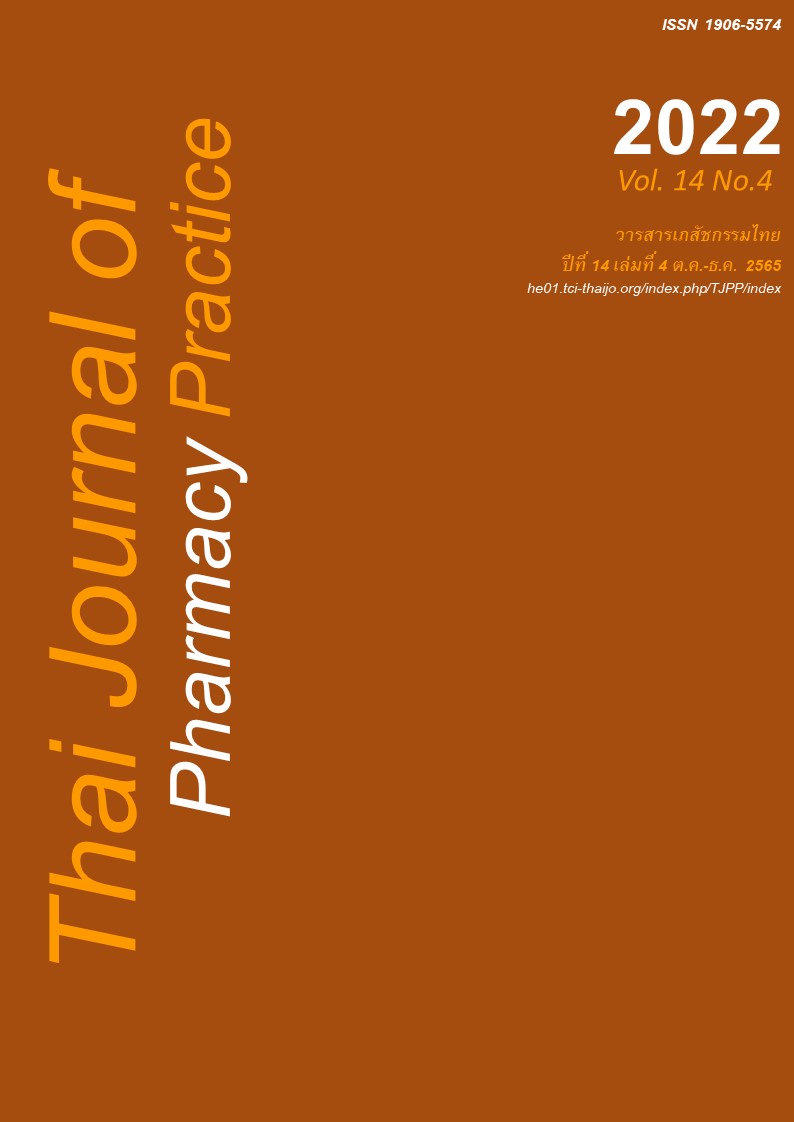ผลของมาตรการควบคุมการใช้ยาปฏิชีวนะตามแนวคิดเศรษฐศาสตร์พฤติกรรม : โรงพยาบาลทั่วไปแห่งหนึ่งในจังหวัดปัตตานี
Main Article Content
บทคัดย่อ
วัตถุประสงค์: เพื่อประเมินผลของมาตรการควบคุมการใช้ยาปฏิชีวนะตามแนวคิดเศรษฐศาสตร์พฤติกรรมโดยเปรียบเทียบอัตราการสั่งใช้ยาปฏิชีวนะและค่าใช้จ่ายก่อนและหลังการดำเนินมาตรการ วิธีการ: การศึกษานี้เป็นงานวิจัยกึ่งทดลองในกลุ่มตัวอย่างกลุ่มเดียวแบบวัดผลก่อนและหลังการแทรกแซงตามแนวคิดเศรษฐศาสตร์พฤติกรรมด้วยการสะท้อนกลับข้อมูลการใช้ยาปฏิชีวนะแก่แพทย์ที่เกี่ยวข้องทั้งหมดเป็นรายบุคคลด้วยรูปแบบความถี่ที่แตกต่างกัน 2 รูปแบบ ได้แก่ มาตรการแทรกแซงรายไตรมาสเป็นจำนวน 8 ไตรมาส (เดือนตุลาคม พ.ศ.2561–เดือนกันยายน พ.ศ.2563) และมาตรการแทรกแซงรายเดือนเป็นจำนวน 6 เดือน (เดือนตุลาคม พ.ศ.2563-เดือนมีนาคม พ.ศ.2564) การประเมินผลทำโดยเปรียบเทียบอัตราการสั่งใช้และมูลค่ายาปฏิชีวนะก่อนและหลังใช้มาตรการแทรกแซง โดยศึกษาในสี่กลุ่มโรคซึ่งมีหลักฐานว่าไม่จำเป็นต้องใช้ยาปฏิชีวนะตามที่โครงการส่งเสริมการใช้ยาอย่างสมเหตุผลกำหนดซึ่งประกอบด้วยแผลสดจากอุบัติเหตุ (fresh traumatic wound: FTW), กลุ่มโรคติดเชื้อที่ระบบทางเดินหายใจส่วนบนและหลอดลมอักเสบเฉียบพลัน (respiratory infection: RI) กลุ่มโรคอุจจาระร่วงเฉียบพลัน (acute diarrhea: AD) และการใช้ยาปฏิชีวนะเพื่อป้องกันการติดเชื้อในสตรีคลอดปกติครบกำหนดทางช่องคลอด (antibiotic prophylaxis in vaginal delivery of normal term labor: APL) การศึกษาใช้การวิเคราะห์อนุกรมเวลาด้วยสมการถดถอยแบบช่วง ผลการวิจัย: มาตรการสะท้อนกลับข้อมูลแก่แพทย์ผู้สั่งใช้ยาสามารถลดอัตราการสั่งใช้ยาปฏิชีวนะได้ทันทีในกลุ่มโรค FTW, RI, AD และสามารถลดมูลค่ายาปฏิชีวนะลงทันทีในกลุ่มโรค FTW, RI, AD และ APL แต่ไม่พบนัยสำคัญทางสถิติ โดยอัตราการสั่งใช้ยาปฏิชีวนะในกลุ่มโรค FTW มีแนวโน้มลดลงร้อยละ 1.89 ต่อไตรมาส (95%CI: -2.72 ถึง -1.07) และมูลค่ายาปฏิชีวนะมีแนวโน้มลดลง 2,935 บาทต่อไตรมาส (95%CI: -4,427 ถึง -1,442) อย่างมีนัยสำคัญทางสถิติ สรุป: การสะท้อนกลับข้อมูลแก่ผู้สั่งใช้ยาเพียงมาตรการเดียว ช่วยลดอัตราสั่งใช้ยาของแพทย์และมูลค่าปฏิชีวนะได้ในบางโรค ควรมีการออกแบบและใช้มาตรการตามแนวทางเศรษฐศาสตร์พฤติกรรมอื่น ๆ ควบคู่กับมาตรการสะท้อนกลับข้อมูล เพื่อเพิ่มประสิทธิผลในการลดอัตราการสั่งใช้ยาปฏิชีวนะในโรงพยาบาล
Article Details

อนุญาตภายใต้เงื่อนไข Creative Commons Attribution-NonCommercial-NoDerivatives 4.0 International License.
ผลการวิจัยและความคิดเห็นที่ปรากฏในบทความถือเป็นความคิดเห็นและอยู่ในความรับผิดชอบของผู้นิพนธ์ มิใช่ความเห็นหรือความรับผิดชอบของกองบรรณาธิการ หรือคณะเภสัชศาสตร์ มหาวิทยาลัยสงขลานครินทร์ ทั้งนี้ไม่รวมความผิดพลาดอันเกิดจากการพิมพ์ บทความที่ได้รับการเผยแพร่โดยวารสารเภสัชกรรมไทยถือเป็นสิทธิ์ของวารสารฯ
เอกสารอ้างอิง
World Health Organization. The world medicines situation. Geneva: World Health Organization; 2004
Chayakul P, Chongtrakul P, Wananukul W, Phunnu phurot P, Karnchanarat P, Yotsombat K, et al. Rational drug use hospital manual. 2nd ed. Nontha- buri: Agricultural Co-Operation Federation of Thai- land; 2015.
Ruangrong J, Theerawattananon Y, Chayketkaew U, Tuntiwet S. Study of interventions and strategies to improve the use of antimicrobials in hospitals in Thailand. Nonthaburi: Health Intervention and Technology Assessment Program; 2009.
Sumpradit N, Anuwong K, Chongtrakul P, Khanab- kaew K, Pumtong S. Outcome of the antibiotics smart use project: a pilot study in Saraburi province Journal of Health Science 2010; 19: 899-911.
Gong CL, Zangwill KM, Hay JW, Meeker D, Doctor JN. Behavioral economics interventions to improve outpatient antibiotic prescribing for acute respiratory infections: a cost-effectiveness analysis. J Gen Intern Med 2018; 34: 846–54.
Burke LE, Styn MA, Sereika SM. Using mHealth technology to enhance self-monitoring for weight loss: a randomized trial. Am J Prev Med 2012; 43: 20–6.
Phaliphot V, Chittiwattanarat K, Ruengorn C, Lucksiri A. Effects of antibiotic restriction program in critical care surgery patients at Maharat nakorn Chaingmai hospital. Thai Pharmaceutical and Health Science Journal 2015; 10: 59-66.
Meeker D, Linder JA, Fox CR, Friedberg MW, Persell SD, Goldstein NJ, et al. Effect of behavioral interventions on inappropriate antibiotics prescribing among primary care practices a randomized clinical trial. JAMA 2016; 315: 562-70.
Kaewpimon P. Health care and quality promotion of vulnerability in multicultural society. Pattani: Faculty of Nursing, Prince of Songkla University; 2016.
Field A. Discovering statistics using SPSS. London: Sage; 2009.
Chaitham A, Chowwanapoonphon H. Development of system for rational antibiotic prescribing: case studies of respiratory infections and simple fresh traumatic wound in a community hospital in upper northern. Thai Journal of Pharmacy Practice 2021; 13: 79-97.
Mohareb AM, Alyssa RL, Sanchez SM, Walensky RP, Hyle EP. Addressing antibiotic overuse in the outpatient setting: Lessons from behavioral economics. Mayo Clinic Proc 2021; 96: 537-42.


